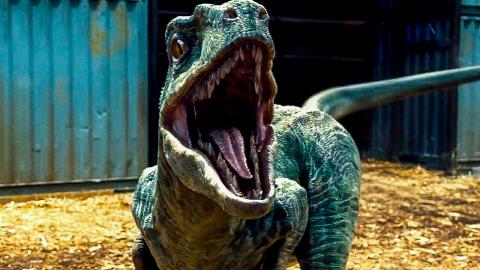Top 10 Coolest Dinosaurs to Ever Roam the Earth

Some of the most famous dinosaurs are also some of the coolest dinosaurs. From the brachiosaurus and it's extremely long neck, to the Stegosaurus and its characteristic spiked tail, to the Spinosaurus, which was basically just a big crocodile on two legs, these prehistoric creatures may be extinct animals, but they're still badass dinosaurs. WatchMojo counts down ten of the most popular dinosaurs to have ever lived.
Special thanks to our users mac121mr0, PowerCosmic901 and Seppe Vervloet for suggesting this idea! Check out the voting page at http://www.WatchMojo.comsuggest/Top%20Ten%20Coolest%20Dinosaurs
Top 10 Coolest Dinosaurs to Ever Roam the Earth
Top 10 Biggest Dinosaurs to Have Ever Walked the Earth
These prehistoric beasts have us wishing for a time machine. Welcome to WatchMojo.com, and today we’re counting down our picks for the top 10 coolest dinosaurs. For this list, we’ll be looking at the dinosaurs we think are the most interesting, while taking into account their overall popularity and how iconic they are. We won’t be including pterosaurs (aka flying reptiles) or marine reptiles on this list, as those are technically not dinosaurs.
#10: Brachiosaurus
Belonging to the long-necked sauropod category of dinosaurs, these tall, titanic creatures are among the most famous members of that group. Compared to their fellow sauropods, Brachiosaurs have more steeply inclined necks, which – thanks to their longer forelimbs and treetop grazing habits – means they were basically the giraffes of the Jurassic period. Although it’s unlikely that brachiosaurs could stand on their hind legs as we’ve seen on film, their distinctive arched heads and familiar posture are now a mainstay of popular fiction, making the brachiosaurus one of the most well known dinos on this list.
#9: Allosaurus
The first of several theropods, or bipedal and generally carnivorous dinosaurs, on this list, the Allosaurus was one of the top predators of its day, taking down medium-sized sauropods and other large herbivores. With a name that means “different lizard,” its body was more evenly proportioned than many of the other large, meat-eating dinosaurs. That means Allosaurs were better suited to running at high speeds, with scientists estimating they could’ve reached up to 34mph. Today, the allosaurus is less recognizable than some of the Cretaceous period theropods, but had “Jurassic Park” been more period accurate, this dino could’ve been the signature predator terrorizing park guests.
#8: Spinosaurus
Large and long, this long-snouted theropod was one of the biggest predators to walk on land – maybe even bigger than a T-Rex. Essentially, the Spinosaurus was a huge crocodile on two legs. But its resemblance to those modern reptiles is more than cosmetic: based on the high location of its nostrils, and fossilized stomach contents that have been discovered, researchers have guessed that the spinosaurus was semi-aquatic and likely specialized in hunting water-based prey – kinda like a croc. With a name derived from its distinctive spinal sails, the spinosaurus – with its resemblance to contemporary reptiles – is a fascinating creature.
#7: Troodon
Sometimes, the smartest hunter is the coolest. Troodon was a small, possibly omnivorous theropod dinosaur, notable for having the highest brain-to-size ratio among dinosaurs; leading some to conclude that it may’ve been the most intelligent dinosaur. And its large, forward-facing eyes may’ve had something to do with its brainpower, since it would’ve needed more intelligence to handle more visual input. It’s also theorized that Troodon’s big peepers allowed it to hunt nocturnally, which would’ve been handy, since it could be found as far north as the Arctic Circle. Despite its possible status as a genius among dinosaurs though, scientists estimate it would’ve only been about as smart a modern bird.
#6: Iguanodon
The Iguanodon holds the distinction of being one of the first dinosaurs ever named. And, although it’s similar in build to other herbivore dinos, it tended to stick out for other reasons – mainly thanks to its so-called “thumbs,” which took the form of spikes. The spiky digits are generally thought to have acted as a form of defense or as a means to break up tough plant growth. What’s more, specimens of the Iguanodon have been found on nearly every continent, so it can claim to be one of the most thoroughly studied species as well.
#5: Ankylosaurus
While many plant-eating dinosaurs relied on their physical size or strength in numbers to protect them, the Ankylosaurus’ approach to self-defence was far more memorable. Ankylosaurus was an herbivore with some of the most impressive natural defenses ever developed; think equal parts dinosaur and modern-day tank. With a body covered in bony, armored plates, a heavy, horned skull, and a thick club at the end of its tail, Ankylosaurus could ward off attacks from many a massive predator. And given that it was alive during the late Cretaceous period, it would’ve faced some of the most notorious dinosaurs to ever walk this earth.
#4: Stegosaurus
Slow in speed and in brainpower, Stegosaurus may not have been the brightest guy around, but its characteristic spinal plates and spiked tail have made this lumbering herbivore one of the most recognizable dinosaurs out there. The evolutionary purpose of its signature plates continues to be debated today, but the most prominent theories suggest they were for display – either to attract mates or deter predators, or possibly as a form of temperature regulation. Fun fact about its other memorable feature: the arrangement of the stegosaurus’ tail spikes is called a “thagomizer.” But scientists didn’t invent the informal term; it was coined in the comic “The Far Side” by creator Gary Larson. No joke!
#3: Deinonychus
Thanks to “Jurassic Park,” this dinosaur is what most people picture when they think of a Velociraptor. Though the two are related, the “Jurassic Park” films and the novels they’re based on rebranded the Deinonychus, probably because, let’s face it, the name “Velociraptor” does sound cooler. But the real Velociraptor was only about the size of a turkey. Deinonychus, on the other hand, was much closer to the man-sized, hunter dinosaurs with the wicked claws everyone loves to see onscreen... even if studios still haven’t given them anatomically accurate feathers.
#2: Triceratops
Few dinosaurs have captured the attention of humans quite like this creature. Like some of our other entries, Triceratops calls to mind a more recent animal – namely the rhinoceros. Its renowned facial horns and bony neck frill, along with its beak-like mouth, give it a great deal more personality than most other dinosaurs. While closely related dinosaurs with more horns and more elaborate frills have been discovered, Triceratops remains the best known and most popular, thanks to its depiction in popular culture as an herbivorous dinosaur capable of going toe-to-toe, or rather tooth-to-horn, with carnivores. Before we get to our top pick, here are a few honorable mentions: - Giganotosaurus - Diplodocus - Pachycephalosaurus
#1: Tyrannosaurus Rex
One of the largest land predators to ever walk the Earth, but not THE biggest as we’ve already seen, the T. Rex was, as its name proclaims, the king of its day. Some theorists have tried to dethrone it, claiming it was more scavenger than hunter, but the recent discovery of a T. Rex tooth embedded in the fossilized remains of an hadrosaur strongly suggests “predator.” Either way, its intimidating size, savagely powerful bite, and those absurdly small forelimbs have cemented it in pop culture as the coolest dinosaur of them all.


 2
2
 0
0
 report
report

 1
1
 0
0
 report
report

 1
1
 0
0
 report
report

 0
0
 0
0
 report
report

 0
0
 0
0
 report
report

